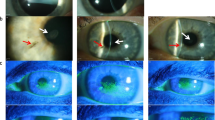Summary
BACKGROUND: To analyse the morphological alterations, epithelial, inflammatory and Langerhans cell density of cornea after longstanding bilateral multiple corneal metal foreign body (FB) injury. PATIENT AND METHODS: Clinical records of a 36 years male patient were reviewed and confocal microscopy was performed two and six years after injury. RESULTS: Corneal FBs were situated in 10–156 μm depth. The wing cells were enlarged around FBs (3564 ± 95/mm2) on visit 1, but their size decreased by visit 2 (3962 ± 71/mm2). No inflammatory cell could be detected while Langerhans cells were randomly seen around FBs (28 ± 3/mm2 on visit 1, and 38 ± 4/mm2 on visit 2 respectively). Subbasal nerves were gracile, fragmented around FBs on visit 1, and remained altered on visit 2. CONCLUSIONS: Our observation may prove that the corneal immune system can tolerate stable intracorneal metal FBs. The longstanding morphological alterations of epithelial cells and subbasal nerves mark the complex impact that such injury can cause.
Zusammenfassung
HINTERGRUND: Auswertung der morphologischen Unterschiede, Epithel-, Entzündungs- und Langerhans'sche Zellen nach einer langjährigen bilateralen Verletzung mit multiplen Metall-Fremdkörpern. PATIENT UND METHODE: Die Augen von einem 36-jährigen männlichen Patienten wurden mit in vivo Konfokalmikroskopie 2 Jahre (Visite 1) bzw. 6 Jahre (Visite 2) nach eine bilateralen Gasofenexplosion Hornhautverletzung untersucht. ERGEBNISSE: Die Fremdkörper lagen zwischen 10–156 Mikrometer Tiefe. Die Flügelzellendichte betrug bei Visite 1 in Fremdkörpernähe (rechtes Auge (RA): 3564±95/mm2, linkes Auge (LA): 3624±73/mm2), bei Visite 2 zeigte sich aber eine Größen-Abnahme, bzw. eine Zunahme der Dichte (RA: 4121±69/mm2, LA: 3962±71/mm2). Keine Entzündungszellen waren zu erkennen, während Langerhans'sche Zellen zufällig um die Fremdkörper verteilt waren (RA:26±4/mm2, LA: 30±7/mm2 bei Visite 1 und RA: 37±4/mm2, LA: 39±5/mm2 bei Visite 2). Subbasale Nerven waren in der Nähe der Fremdkörper dünn verteilt. SCHLUSSFOLGERUNG: Unsere Beobachtungen zeigen, dass das Immunsystem der Hornhaut stabile intrakorneale Fremdkörper vertragen kann. Die langdauernden, morphologischen Veränderungen der Epithelzellen und der subbasalen Nerven zeigen den komplexen Heilungsprozeß der Hornhaut nach einer solchen Verletzung.
Similar content being viewed by others
Literatur
Fea A, Bosone A, Rolle T, Grignolo FM (2008). Eye injuries in an Italian urban population: report of 10620 cases admitted to an eye emergency department in Torino. Graefe's Arch. Clin. Exp. Ophthalmol. 246: 175–179
Guthoff RF, Zhivov A, Stachs O (2009). In vivo confocal microscopy, an inner vision of the cornea – a major review. Clinical and Experimental Ophthalmology 37: 100–117
Zhivov A, Stave J, Vollmar B, Guthoff R (2005). In vivo confocal microscopic evaluation of Langerhans cells density and distribution in the normal corneal epithelium. Graefe's Arch. Clin. Exp. Ophthalmol. 243: 1056–1061
Zhivov A, Stave J, Vollmar B, Guthoff R (2007). In Vivo Confocal Microscopic Evaluation of Langerhans Cell Density and Distribution in the Corneal Epithelium of Healthy Volunteers and Contact Lens Wearers. Cornea 26: 47–54
Doulas K, Apostolakis K, Feretis D (2003). A longstanding, deep, intracorneal foreign body. Acta Ophthalmologica Scandinavica 81: 81–2
Jeng BH, Whitcher JP, Margolis TP (2004). Intracorneal Graphite Particles Cornea 23: 319–320
Resch MD, Imre L, Tapasztó B, Németh J (2008). Confocal microscopic evidence of increased Langerhans cell activity after corneal metal foreign body removal. European Journal of Ophthalmology 18: 703–707
Eckard A, Stave J, Guthoff RF. (2006). In vivo investigations of the corneal epithelium with the confocal Rostock Laser Scanning Microscope (RLSM). Cornea 25 (2):127–31
Author information
Authors and Affiliations
Corresponding author
Additional information
Ein Erratum zu diesem Beitrag ist unter http://dx.doi.org/10.1007/s00717-011-0032-2 zu finden.
Rights and permissions
About this article
Cite this article
Marsovszky, L., Maneschg, O., Németh, J. et al. Hornhaut Konfokal-Mikroskopie bei einer bilateralen Augenverletzung mit multiplen kornealen Fremdkörpern. Spektrum Augenheilkd. 25, 231–233 (2011). https://doi.org/10.1007/s00717-011-0011-7
Received:
Accepted:
Issue Date:
DOI: https://doi.org/10.1007/s00717-011-0011-7




